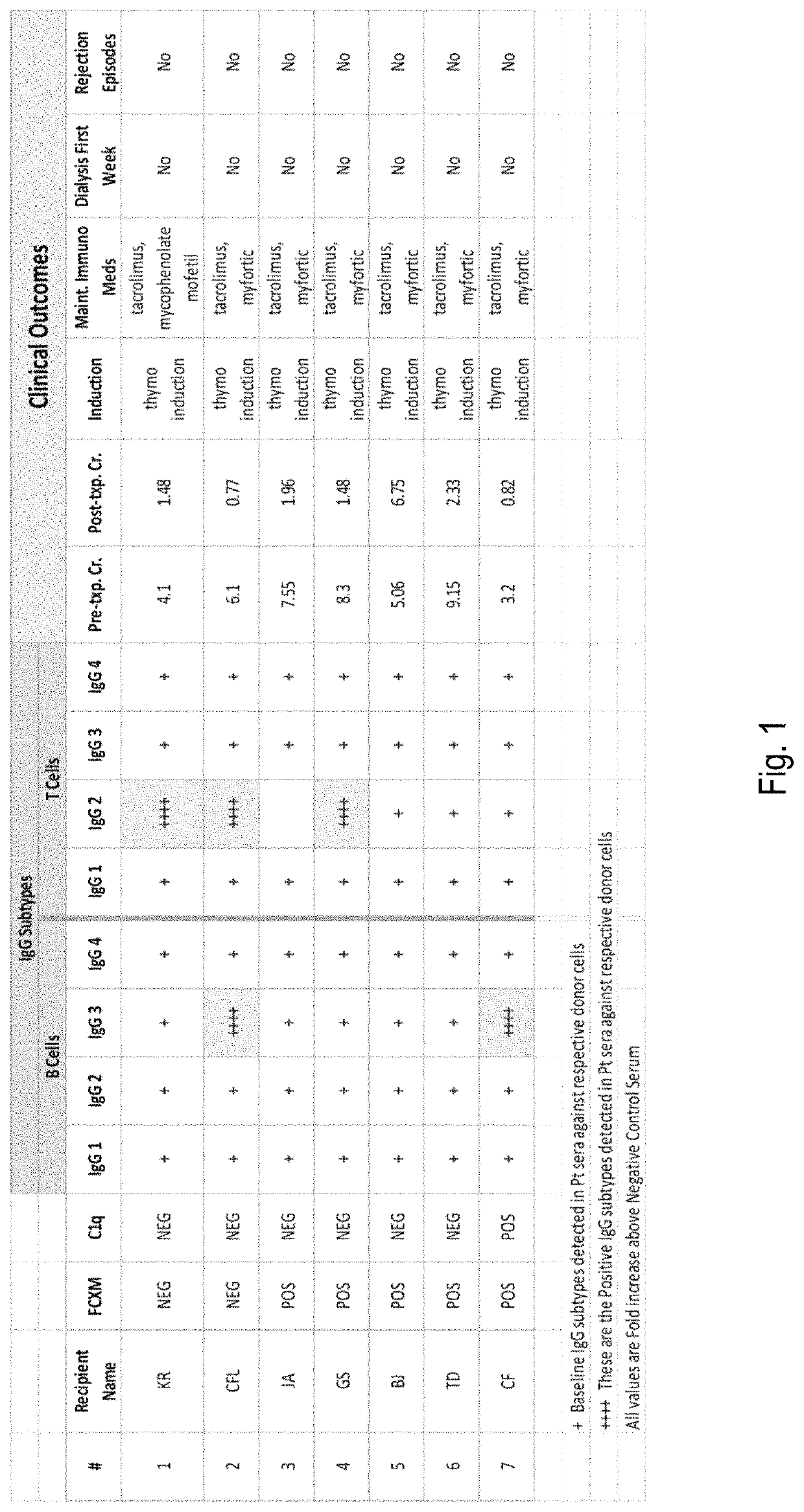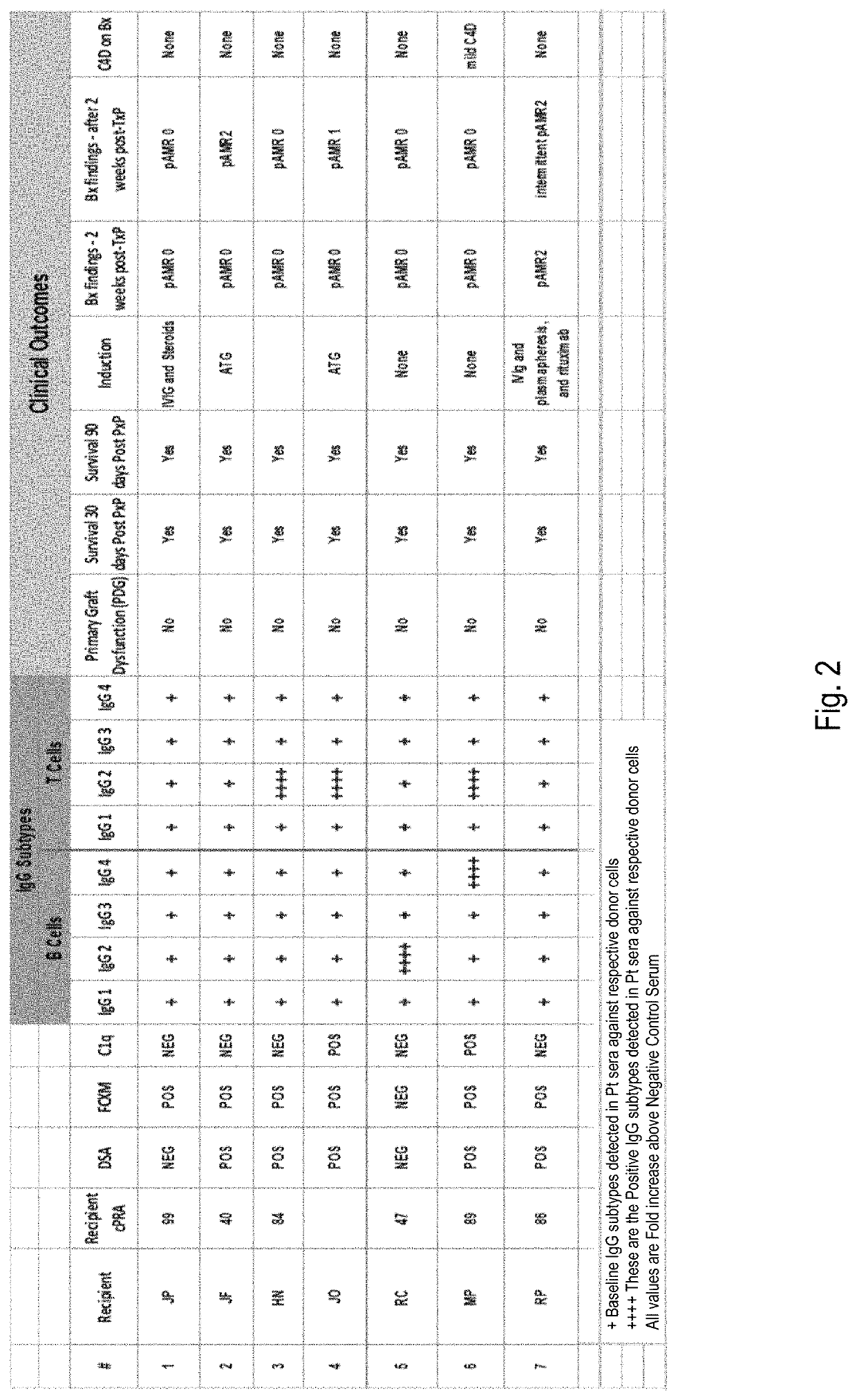IgG subtyping assay for identifying transplantable tissue samples
a tissue sample and subtyping technology, applied in the field of organ and tissue transplantation, can solve the problems of laborious assays, insufficient indicativeness, and inability to achieve the goals of transplantation,
- Summary
- Abstract
- Description
- Claims
- Application Information
AI Technical Summary
Benefits of technology
Problems solved by technology
Method used
Image
Examples
example 1
[0027]Isolation of PBMCs from Donor Blood
[0028]Peripheral Blood Mononuclear Cells (PBMCs, which include both lymphocytes and monocytes) were isolated from donor whole blood that was collected in acid citrate dextrose (ACD) vacutainer tubes. Donor blood was transferred to 15 milliliter conical tubes and mixed with 2 milliliters methyl cellulose (1% solution, weight / volume; Sigma-Aldrich, St. Louis, Mo., USA) by inversion. The tube was rotated in a 37 degrees Celsius incubator for 15 minutes and left standing at 37 degrees Celsius for an additional 30 minutes to separate the plasma layer containing enriched lymphocytes from the red blood cells layer. The plasma layer was carefully transferred to a fresh 15 milliliter conical tube and diluted with dulbecco's phosphate-buffered saline (DPBS, Lonza, Walkersville, Md., USA) at a ratio of 1:1 (plasma:DPBS) and mixed by inversion.
[0029]Using a Pasteur pipette, the diluted plasma was underlaid with lymphocyte separation medium (LSM) such tha...
example 2
[0034]Protocol for Identification of IgG Subtypes by Flow Cytometry
[0035]The following description is similar to the procedures described in Example 1, with some minor variations.
[0036]Isolate PBMC from whole blood or using frozen PBMC.
[0037]Wash twice with phosphate-buffered saline (PBS, pH 7.4) and perform a viability count.
[0038]Centrifuge at 1500 rpm for 5 minutes.
[0039]Discard the supernatant and resuspend the cell pellet in 0.3 ml FcR blocker reagent per 107 cells (Innovex Cat # NB309).
[0040]Incubate at room temperature (ca. 20 degrees Celsius) for 10 minutes.
[0041]Wash with excess PBS twice.
[0042]Resuspend the cells in 107 cells / ml in staining buffer (i.e., phosphate-buffered saline, pH 7.4, containing 5% v / v fetal bovine serum).
[0043]Aliquot 100 microliters per test (106 per test) of cell suspension to each 12×75 mm tube.
[0044]Add 20 microliters neat serum to each tube.
[0045]Incubate at 4 degrees Celsius for 30 minutes.
[0046]Wash with 2.5 ml staining buffer.
[0047]Discard the...
example 3
[0053]Using IgG Subtyping in Heart Transplantation Across a Positive Flow-Cytometry Cross Match (FCXM)
[0054]A positive FCXM is often a deterrent to heart transplantation due to the risk of hyperacute rejection and antibody-mediated rejection (AMR). While highly sensitive to the presence of donor-specific antibodies, FXCM does not determine whether these antibodies bind complement or not.
[0055]Case Report: 61 year old African-American male with coronary artery disease developed following myocardial infarction and coronary artery bypass graft, who developed heart failure due to ischemic cardiomyopathy with ejection fraction (EF) 15-20%. Due to progressive symptoms despite medical therapy and implantation of a cardiac resynchronization therapy device, he had a Heart Mate II left ventricular assist device (LVAD) implanted as a bridge to transplant. Post-LVAD course was complicated by recurrent gastrointestinal bleed requiring multiple transfusions as well as a driveline exit site infect...
PUM
| Property | Measurement | Unit |
|---|---|---|
| weight/volume | aaaaa | aaaaa |
| weight/volume | aaaaa | aaaaa |
| volume | aaaaa | aaaaa |
Abstract
Description
Claims
Application Information
 Login to View More
Login to View More - R&D
- Intellectual Property
- Life Sciences
- Materials
- Tech Scout
- Unparalleled Data Quality
- Higher Quality Content
- 60% Fewer Hallucinations
Browse by: Latest US Patents, China's latest patents, Technical Efficacy Thesaurus, Application Domain, Technology Topic, Popular Technical Reports.
© 2025 PatSnap. All rights reserved.Legal|Privacy policy|Modern Slavery Act Transparency Statement|Sitemap|About US| Contact US: help@patsnap.com


